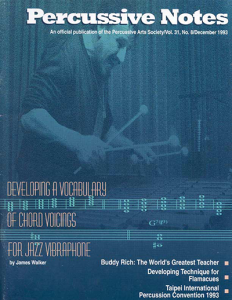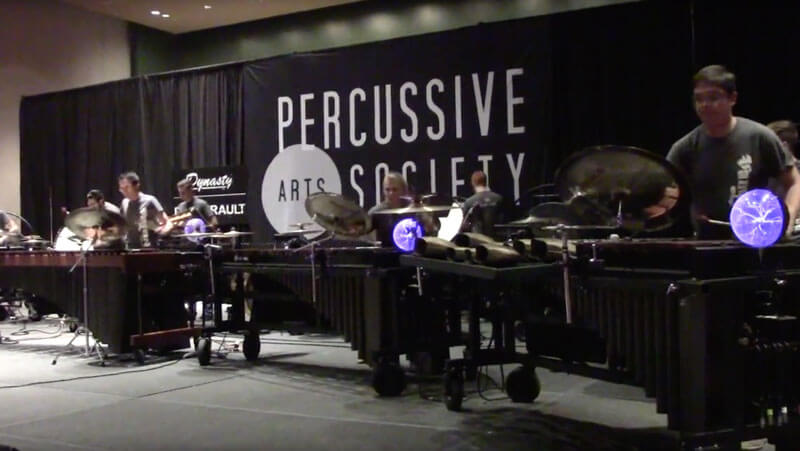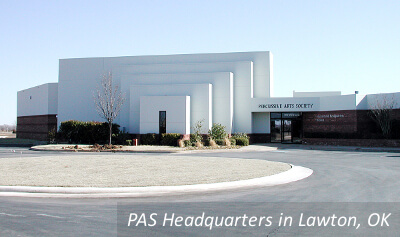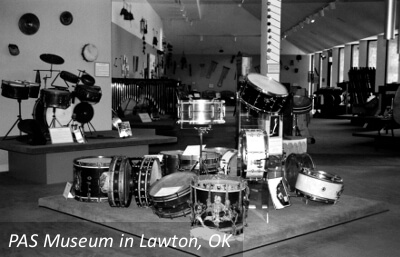History
With more than 60 years of history, the Percussive Arts Society (PAS) is a non-profit, music-service organization whose mission is to inspire, educate, and support percussionists and drummers throughout the world. Today, the society is nearly 6,000 members strong, with 48 chapters located across the United States and an additional 20 chapters around the globe.

PAS publishes the Percussive Notes journal six times a year, shares weekly content on the PAS Blog, the official blog of the Percussive Arts Society, publishes DRUMSET Magazine quarterly, and maintains a comprehensive website of percussion education resources. The society maintains a percussion collection and archive library and presents percussion-based programming in the local community. Each year PAS hosts the largest percussion convention in the world, the Percussive Arts Society International Convention (PASIC), featuring the top names in drumming and percussion. In addition, domestic and international PAS chapters host Days of Percussion and other clinics in their regions throughout the year. The fourteen percussionists and educators who met for dinner at the 1960 Midwest Band and Orchestra Clinic in Chicago could scarcely have imagined what the PAS would ultimately grow into. Their goal was simply to discuss the possibility of establishing a national organization that would “bring up to date the present standards in solo and ensemble contests, stimulate a greater interest in percussion performance and teaching, and promote better teaching of percussion instruments.”
In January, 1961 during the SW-MENC convention in Albuquerque, New Mexico, a meeting was held at which Jim Sewrey suggested the name Percussive Arts Society to Remo Belli. Following this meeting, Robert Winslow, a professional percussionist and North Hollywood band director who served as an educational advisor to Belli, sent a letter proclaiming: “The Percussive Arts Society is open for business,” and in September, 1961, the society sent its first publication, Percussive Arts Society Bulletin, printed on a mimeograph machine donated by Belli, to the membership. The fourteen originating members listed in the first Percussive Arts Society Bulletin were Remo Belli, Warren Benson, Mervin Britton, Robert Buggert, Don Canedy, Rey Longyear, Charles Lutz, Jack McKenzie, James L. Moore, Verne Reimer, Jim Salmon, Hugh W. Soebbing, Charles Spohn, and Robert Winslow.

After three Bulletins, the administrative and publication duties of the society were transferred to Donald Canedy, percussion instructor and band director at Southern Illinois University. In April of 1963, Canedy, with the advice of a distinguished editorial board and an able group of contributing editors, published the new PAS journal, Percussionist (later called Percussive Notes Research Edition). In 1967, James L. Moore’s already successful magazine, Percussive Notes, became an official PAS publication.
Canedy served as de facto president through 1964, when, at the December Percussive Arts Society meeting in Chicago, a constitution was adopted and officers were elected. Gordon Peters became the first President of PAS, Jack McKenzie took the position of First Vice-President, and Canedy was named Executive Secretary. Also elected were a board of directors and an editorial board. With this structure, the society became increasingly influential, expanding its committee activities to address important percussion issues and making policy decisions that would result in important contributions to all areas of percussion.
Beginning in 1971, performances and clinics called Days of Percussion were held in conjunction with the yearly business meetings. In 1974, the first Percussive Arts Society National Conference (PASNC) was held in Anaheim and at California State University at Northridge. The PASNC evolved into the Percussive Arts Society International Convention that we know today as PASIC. The first PASIC was held in 1976 at the Eastman School of Music in Rochester, New York, and was hosted by John Beck, the Eastman School, and the New York State PAS Chapter.
In 1972, PAS established its Hall of Fame to recognize the contributions of the most highly regarded professional leaders in percussion performance, education, research, scholarship, administration, composition, and the industry. The awards are presented every year at PASIC.
Since 1974, the PAS Composition Contest has encouraged the creation of hundreds of new works, many of which have become part of the standard percussion repertoire.
In 1979, the PAS Marching Percussion Committee appointed the PAS International Drum Rudiment Committee to act as the governing body in the revision and standardization of the 26 rudiments. A new listing of 40 International Drum Rudiments was adopted by PAS in 1984 and included drum corps, orchestral, European, and contemporary drum rudiments.

For its first two decades, the PAS office was located primarily in Terre Haute, Indiana. In 1981, the society’s success and growth brought about the need to hire a staff to handle the society’s day-to-day operations. So PAS rented office space in Urbana, Illinois, where then vice-president Tom Siwe was a teacher at the University of Illinois. In 1989, the society was informed that its office would no longer be available and a move was required. Through PAS board member Dr. James Lambert, the McMahon Foundation in Lawton, Oklahoma was solicited for possible support for the construction of a headquarters and museum facility in Lawton. Upon approval of the PAS Board of Directors and approval of a 2-for-1 matching grant for construction, PAS relocated and the Percussive Arts Society International Headquarters and Percussive Arts Museum were officially opened August 8, 1992. Instrument donations to the museum quickly used up all available display space, so an addition was constructed, adding another 4,000 square feet to the museum. The expanded museum reopened in August, 1995. Another addition to the building was completed in 2001.

During the early 1990s, in the early stages of the Internet, PAS was at the forefront of the emerging technology with the development of the World Percussion Network (WPN), a bulletin board system that allowed PAS members to share information via computer modems. With the development of the World Wide Web, PAS developed a Website (www.pas.org) that contains publication archives, research databases, a conference center, museum tour, and other features.
In 2005, after a nationwide search and formal proposal process, the PAS Board of Directors elected to relocate the headquarters, museum, and library to Indianapolis where, for the first time, PAS would be able to operate its headquarters, house its museum and library, and present its annual convention in the same city. PAS moved its operations in 2007, and the new museum with its now extensive collection of instruments from around the world and library of archives, scores, and recordings opened in 2009 in Indianapolis.
In addition to the Hall of Fame award, each year at PASIC the society presents four awards to recognize individuals who have made significant contributions in service to PAS or the field of percussion: Outstanding Service Award, Outstanding Supporter Award, Outstanding Chapter Award, and the President’s Industry Award. PAS also recognizes outstanding educators through the Lifetime Achievement in Education Award, which is the society’s most prestigious award next to the Hall of Fame.
Today, the Percussive Arts Society has 16 standing committees, as well as the Diversity Alliance, that address specific areas of percussion performance, research, education, pedagogy, and the percussion community. PAS committees and the Diversity Alliance play an essential role in advancing percussion through the development and dissemination of the latest information, research, and initiatives. In addition, PAS continues to support percussion education through a variety of chapter activities, as well as through a number of annual scholarships and competitions.
The society maintains strategic partnerships with Drum Corps International (DCI), Winter Guard International (WGI), Music for All, the Percussion Marketing Council (PMC), Music Educators National Conference (MENC), and the National Association of Music Merchants (NAMM). PAS is the world’s largest percussion organization and is the central source for information and networking for percussionists and drummers of all ages.
Additional Reading
*Must be a PAS member at the VIP or All Access Level








